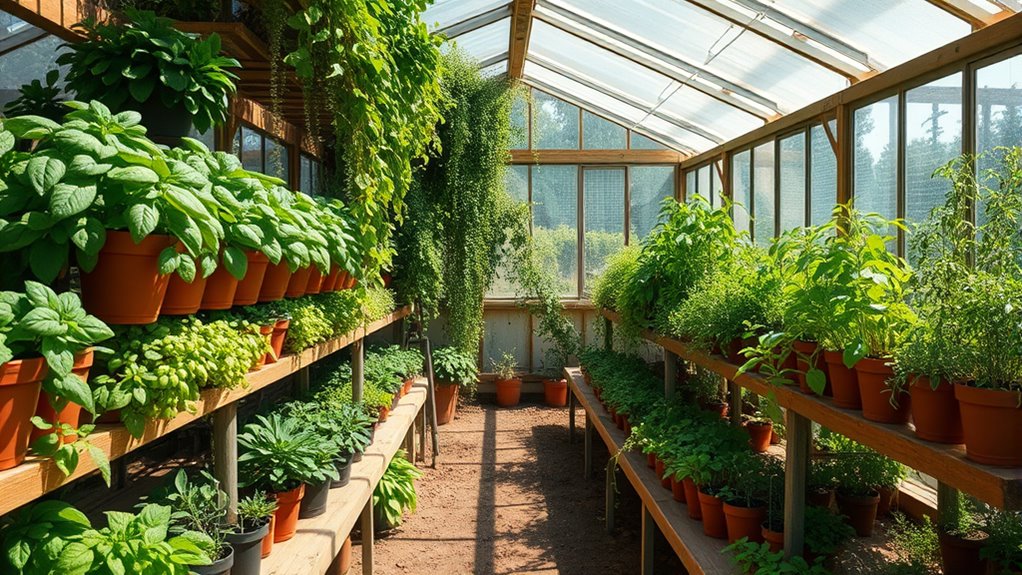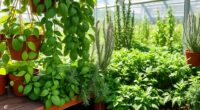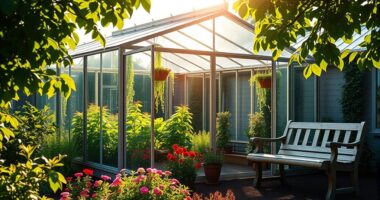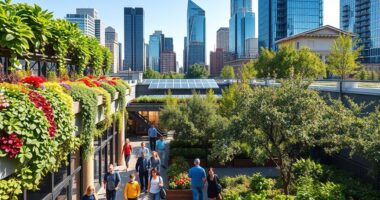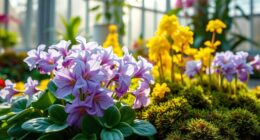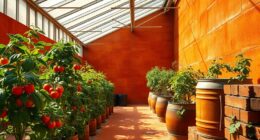If you're looking to grow fresh herbs year-round, I've found some fantastic greenhouse plans to help you get started. These designs vary from simple hoop houses to advanced solar greenhouses, ensuring you can find the right fit for your space and budget. I've seen how effective insulation and proper ventilation can make a big difference in growth. If you stick around, I'll share more insights on choosing the best plans for your herb garden.
Key Takeaways
- Explore detailed guides like "Herb Greenhouse Plans for Growing Fresh Herbs" for practical design, heating, and watering tips tailored for year-round cultivation.
- Utilize the "Black & Decker Complete Guide to DIY Greenhouses" for comprehensive construction plans, covering essential components like ventilation and insulation.
- Consider Year-Round Solar Greenhouse designs that incorporate sustainable heating systems like GAHT for optimal herb growth in varying climates.
- Look for resources emphasizing low-cost, passive solar solutions to reduce operational costs while maintaining effective herb production throughout the year.
- Ensure chosen plans include considerations for humidity control, proper materials, and accessibility to maximize the health and yields of your herbs.
Effortless Greenhouse Gardening for Beginners
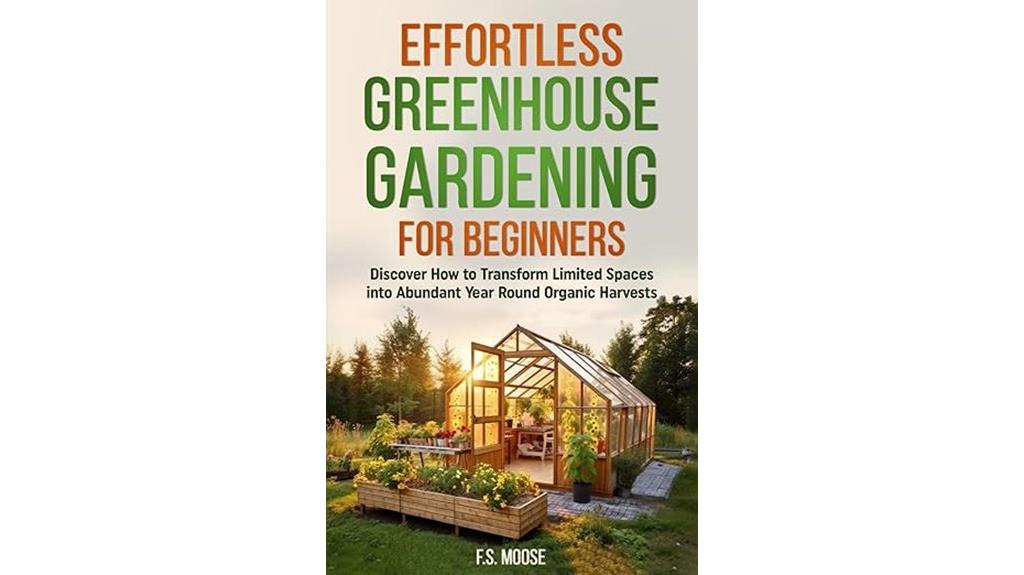
If you're new to gardening and want to grow fresh herbs year-round, "Herb Greenhouse Plans for Growing Fresh Herbs" is the perfect choice for you. This guide, "Effortless Greenhouse Gardening for Beginners," simplifies the entire process. It walks you through planning, building, and maintaining your greenhouse with easy-to-follow steps. You'll find valuable tips on selecting plants, pest management, and ensuring ideal growing conditions. Plus, the clear charts and engaging images make learning fun! After diving into this book, I felt ready to tackle my gardening adventures, even in limited spaces. You'll love the satisfaction of growing your own herbs!
Best For: Individuals new to gardening who want to grow fresh herbs year-round in a manageable and efficient way.
Pros:
- Comprehensive guidance: Offers step-by-step instructions for planning, building, and maintaining a greenhouse.
- Practical tips: Provides research-backed advice on plant selection, pest management, and creating optimal growing conditions.
- User-friendly format: Includes clear charts and engaging images that make learning enjoyable and accessible.
Cons:
- Limited advanced techniques: May not cover highly specialized or advanced gardening methods in depth.
- Space constraints: Some techniques may not be suitable for those with very limited space or resources.
- Not for seasoned gardeners: Experienced gardeners might find the information too basic or simplistic.
Greenhouse Gardening for Beginners Guide
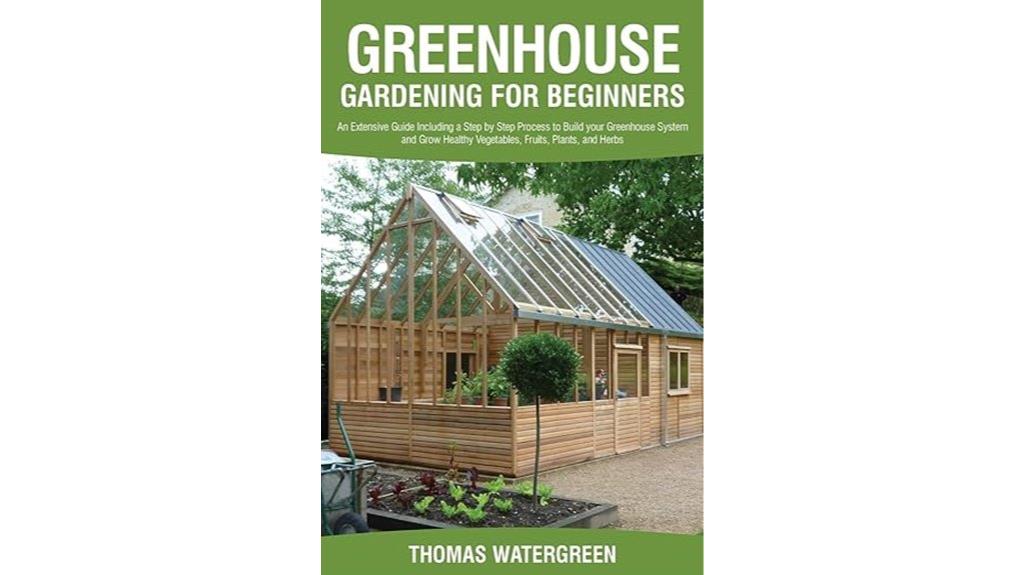
For those new to gardening, the "Herb Greenhouse Plans for Growing Fresh Herbs" truly stands out as an ideal choice. I've found that building a greenhouse can be straightforward, with various sizes and shapes to suit your space. Following a step-by-step process makes it manageable. The benefits are immense—protection from harsh weather enhances growth and productivity. Plus, techniques like hydroponics and aquaponics offer efficient ways to cultivate healthy herbs. By shielding your plants from extreme conditions, you greatly reduce the risk of plant death and boost yields. This guide is perfect for anyone enthusiastic to engage in greenhouse gardening!
Best For: Beginners who are eager to learn about greenhouse gardening and want to grow fresh herbs efficiently.
Pros:
- Provides protection against harsh weather, enhancing plant growth and productivity.
- Offers efficient gardening techniques like hydroponics and aquaponics for healthy herb cultivation.
- Step-by-step building process makes it accessible for those new to gardening.
Cons:
- Initial construction costs can be high depending on the size and materials chosen.
- Requires a learning curve to understand greenhouse management and specific gardening techniques.
- Space limitations may restrict the size and type of greenhouse that can be built.
The Year-Round Solar Greenhouse: Design and Build a Net-Zero Energy Greenhouse
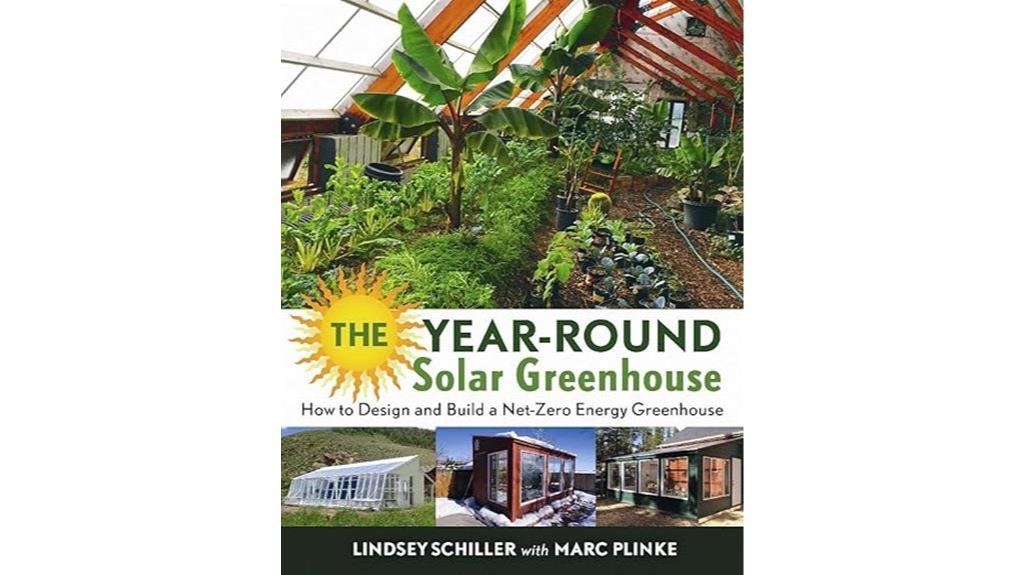
The Year-Round Solar Greenhouse is ideal for those who want to grow fresh herbs sustainably, as it combines innovative design with practical techniques to create an energy-efficient environment. I found the GAHT system particularly intriguing; it utilizes underground piping to maintain warmth, preventing winter freezes. The book's engaging style made it easy to grasp various construction methods, although beginners might need to seek additional details. Overall, it's a fantastic resource that boosts my confidence in building a solar greenhouse. I highly recommend diving into its extensive insights to enhance your greenhouse journey and expand your herb-growing potential year-round.
Best For: Those interested in sustainable gardening and innovative greenhouse construction techniques.
Pros:
- Engaging and clear writing style makes the content accessible and easy to understand.
- Comprehensive coverage of various greenhouse building techniques enhances learning and application.
- Innovative features like the GAHT system offer practical solutions for year-round growing.
Cons:
- Some readers may find a lack of detailed guidance on specific construction techniques.
- Beginners might require additional resources to fully implement the concepts presented.
- The broad overview may not satisfy those looking for in-depth technical information.
How to Build Your Own Greenhouse: Designs and Plans
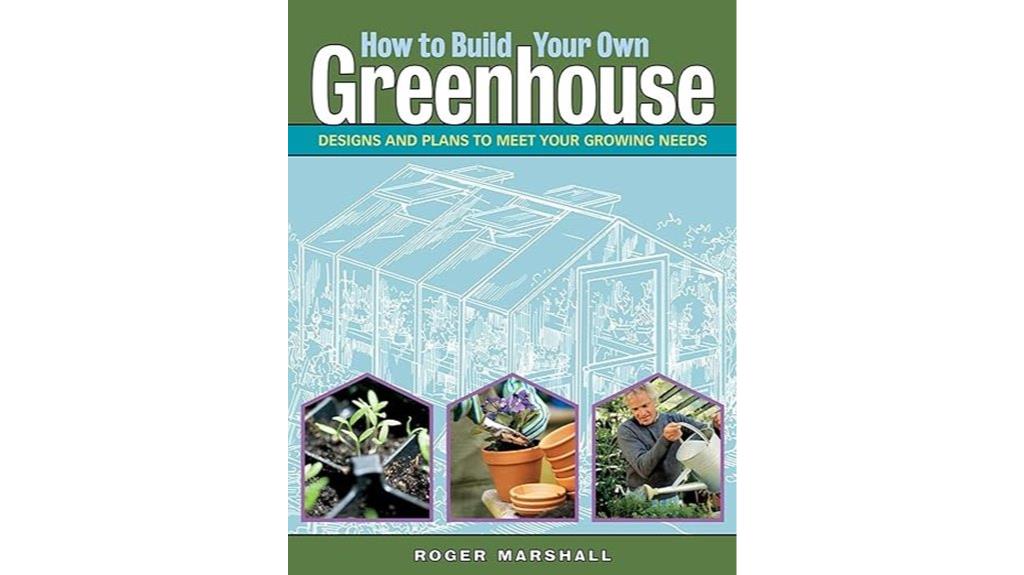
Building your own greenhouse can be an exciting venture, especially for those passionate about growing fresh herbs. I found an extensive guide that covers essential design considerations tailored to various climates and plant types. It's perfect for both beginners and seasoned builders. The clear concepts, pictures, and drawings made it easy for me to communicate ideas, whether I was tackling DIY projects or working with contractors. While it doesn't dive deep into specialized topics like aquaponics, it remains a solid resource for standard greenhouse projects. I highly recommend this book for anyone ready to take on greenhouse ownership!
Best For: DIY greenhouse builders aiming for professional-quality results and comprehensive design insights.
Pros:
- Offers extensive design considerations for various climates and plant types.
- Includes clear concepts, pictures, and drawings for easy communication with architects or contractors.
- Provides practical advice and thoughtful insights for effective planning and construction.
Cons:
- May overwhelm those seeking only basic greenhouse structures.
- Limited information on specialized topics like aquaponics.
- More informative than cheaper alternatives, potentially making it less accessible for budget-conscious individuals.
Greenhouse Gardening for Beginners: Build Your Own Greenhouse
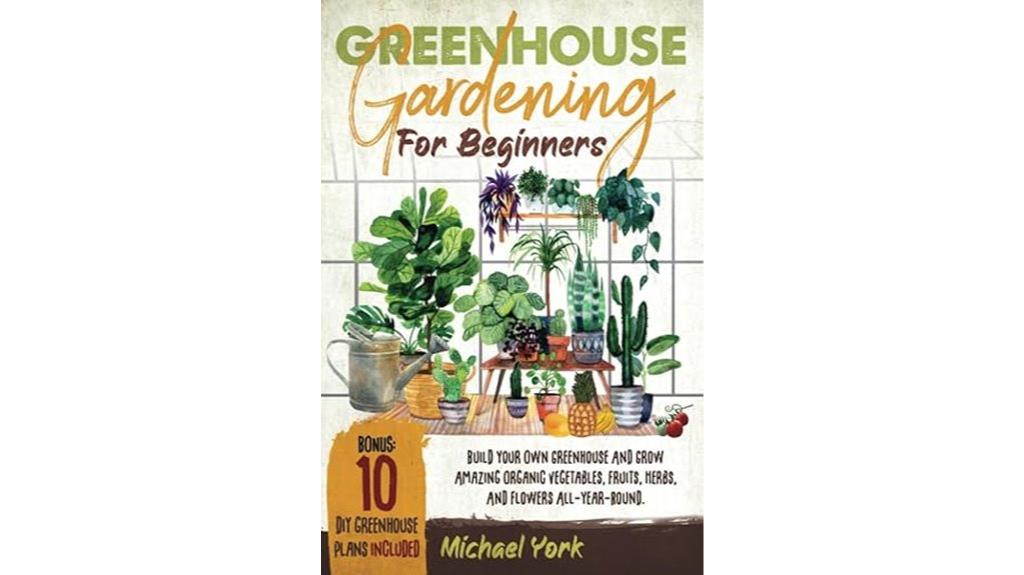
If you're enthusiastic to cultivate your own fresh herbs but feel overwhelmed by the idea of starting a greenhouse, "Herb Greenhouse Plans for Growing Fresh Herbs" is perfect for you. I found Michael York's "Greenhouse Gardening for Beginners" incredibly helpful. It walks you through selecting the right structure and managing temperature and humidity. You'll appreciate the step-by-step instructions for building and maintaining your greenhouse. Plus, the year-round planting calendar keeps your herb garden thriving. With practical tips on pest control and troubleshooting, you'll confidently navigate any challenges. This book truly sets you up for a successful greenhouse gardening adventure!
Best For: Beginners interested in starting greenhouse gardening and growing their own fresh herbs.
Pros:
- Clear step-by-step instructions make building and maintaining a greenhouse accessible for novices.
- Includes a year-round planting calendar to ensure continuous herb production.
- Offers practical tips on pest control and troubleshooting for a healthy gardening experience.
Cons:
- Some readers may find the focus on greenhouse construction less extensive than desired for gardening content.
- Certain advanced gardening techniques might not be covered in depth, limiting insights for experienced gardeners.
- DIY projects may require additional materials and effort that some beginners might find challenging.
The Chinese Greenhouse: Design and Build a Low-Cost, Passive Solar Greenhouse
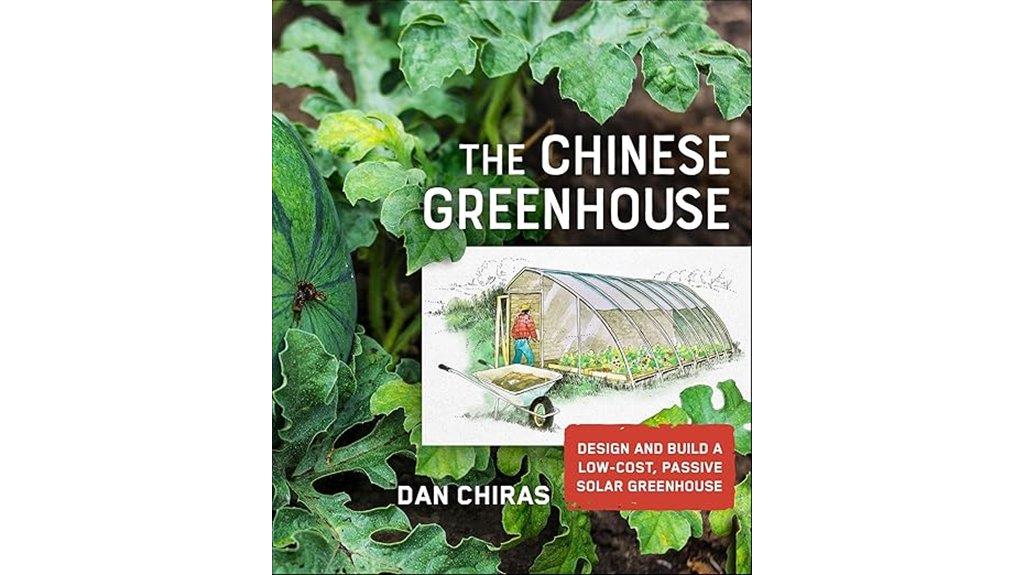
For those enthusiastic to cultivate fresh herbs year-round without the burden of high energy costs, the Chinese greenhouse offers an ideal solution. I found Dan Chiras's book invaluable for understanding how to design and build a low-cost, passive solar greenhouse. It's packed with clear explanations about thermal properties and structural design, making it easy to follow. The practical illustrations helped me visualize the construction process. While some readers experienced minor issues with the book, overall, I felt it was a worthy investment. If you're looking for sustainable gardening options, I highly recommend this guide for your herb-growing journey.
Best For: Individuals seeking to cultivate herbs year-round in a sustainable and low-cost manner.
Pros:
- Clear explanations on thermal properties and structural design make the content easy to understand.
- Practical illustrations enhance visualization of the construction process for effective greenhouse building.
- Offers a low-cost, passive solar solution that can significantly reduce food costs if widely adopted.
Cons:
- Some readers reported issues with book quality, such as upside-down pages and water damage.
- Limited new information compared to concepts available online, according to some readers.
- May not be as comprehensive as other resources for those already familiar with greenhouse design.
The Earth Sheltered Solar Greenhouse Book
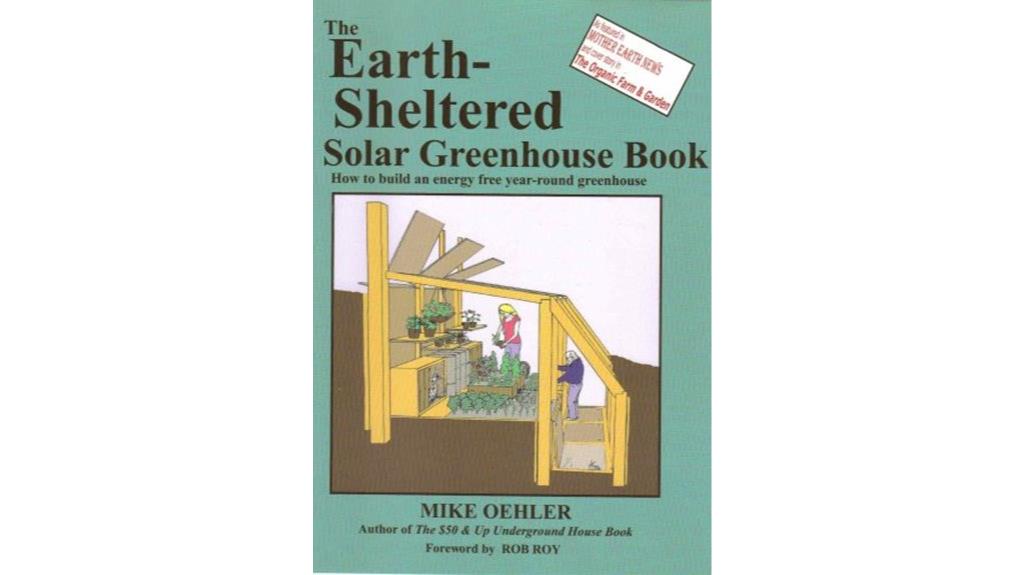
Those looking to create a self-sufficient greenhouse in a cold climate will find "The Earth Sheltered Solar Greenhouse Book" particularly valuable. It dives into underground building techniques and how to harness passive heating from the earth, making it perfect for places like Wyoming with harsh winters. While I found the step-by-step instructions easy to follow, some details felt a bit generalized. However, the author's relatable anecdotes about mistakes made during construction kept me engaged. This book inspired me to tackle my own greenhouse project, despite my limited building experience. It's a worthwhile investment for anyone seeking affordable greenhouse alternatives!
Best For: Those interested in creating self-sufficient greenhouses in cold climates looking for practical and innovative building techniques.
Pros:
- Clear and concise instructions make it accessible for readers of all experience levels.
- The author's personal anecdotes provide relatable insights and help avoid common pitfalls.
- Inspiring content that motivates readers to embark on their own greenhouse projects.
Cons:
- Some instructions may feel generalized, which could leave readers with limited building experience feeling uncertain.
- Certain information and building techniques may be outdated.
- Limited detailed guidance may not satisfy those seeking in-depth construction methods.
Greenhouse Gardening: How to Build a Greenhouse and Grow Vegetables, Herbs, and Fruit All Year-Round
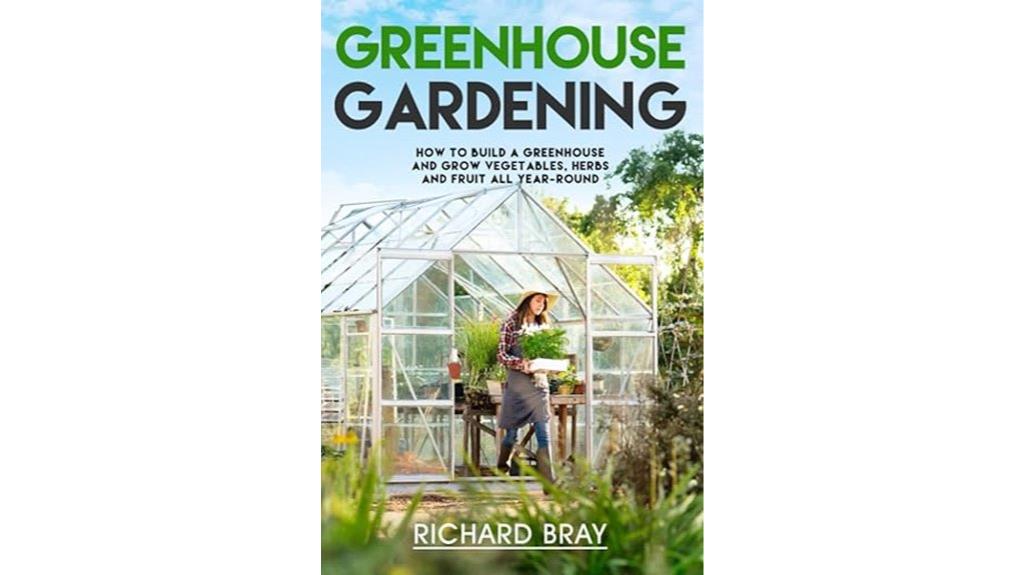
Greenhouse gardening opens up a world of possibilities for anyone enthusiastic to grow fresh herbs year-round, especially beginners looking to enhance their culinary experiences. I found the book "Greenhouse Gardening" incredibly helpful in getting started. It breaks down different greenhouse types, their pros and cons, and offers simple construction guidance. I appreciated the practical advice on maintenance and effective usage, which is essential for newcomers like me. The clear information on lighting, heating, and plant selection empowered me to maximize my greenhouse. This resource really inspired my gardening journey, making it accessible and enjoyable to grow vegetables, herbs, and fruit all year long.
Best For: Beginners interested in building and maintaining a greenhouse for year-round gardening.
Pros:
- Provides clear and basic information suitable for novices.
- Covers various greenhouse types, including their pros and cons, aiding in informed decision-making.
- Offers practical advice on construction, maintenance, and effective usage of greenhouses.
Cons:
- May lack depth for experienced gardeners seeking advanced techniques.
- Some readers found the content to be somewhat generic.
- Limited to 100 pages, which may not cover all aspects of greenhouse gardening in detail.
Black & Decker Complete Guide to DIY Greenhouses
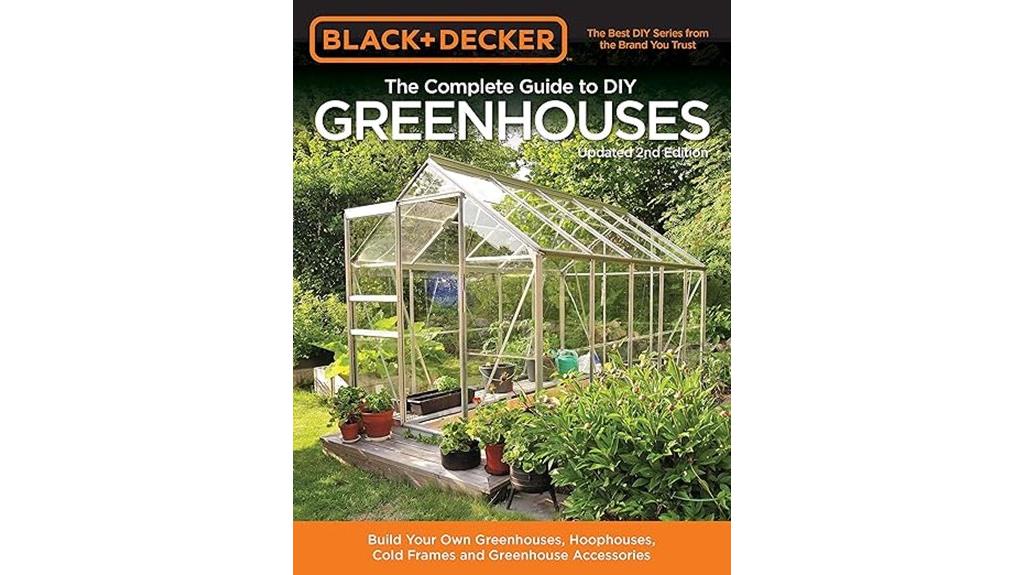
If you're a DIY enthusiast enthusiastic to cultivate fresh herbs right at home, the "Black & Decker Complete Guide to DIY Greenhouses" is the perfect resource for you. This book offers detailed construction plans for various greenhouse types, including hoophouses and cold frames. I love its extensive color photography and clear dimensions, making it easy for both beginners and seasoned gardeners to follow. The guidance on essential components like ventilation and insulation has been invaluable. Plus, it covers additional structures that enhance your gardening experience. Overall, it's a worthwhile investment for anyone serious about building their own greenhouse.
Best For: DIY enthusiasts and gardeners looking to construct their own greenhouses with comprehensive guidance and support.
Pros:
- Extensive color photography and detailed construction plans make it accessible for beginners and experienced gardeners alike.
- Covers essential components like ventilation, insulation, and additional garden structures, enhancing overall gardening experience.
- User-friendly layout and organization of content facilitate easy navigation and understanding.
Cons:
- Some inaccuracies in specific measurements may require adjustments during construction.
- Certain users may ultimately prefer to purchase a greenhouse instead of building one, despite the book's guidance.
- Limited coverage of advanced techniques may not satisfy highly experienced builders seeking in-depth information.
Hydroponics and Greenhouse Gardening: 3-in-1 Gardening Book
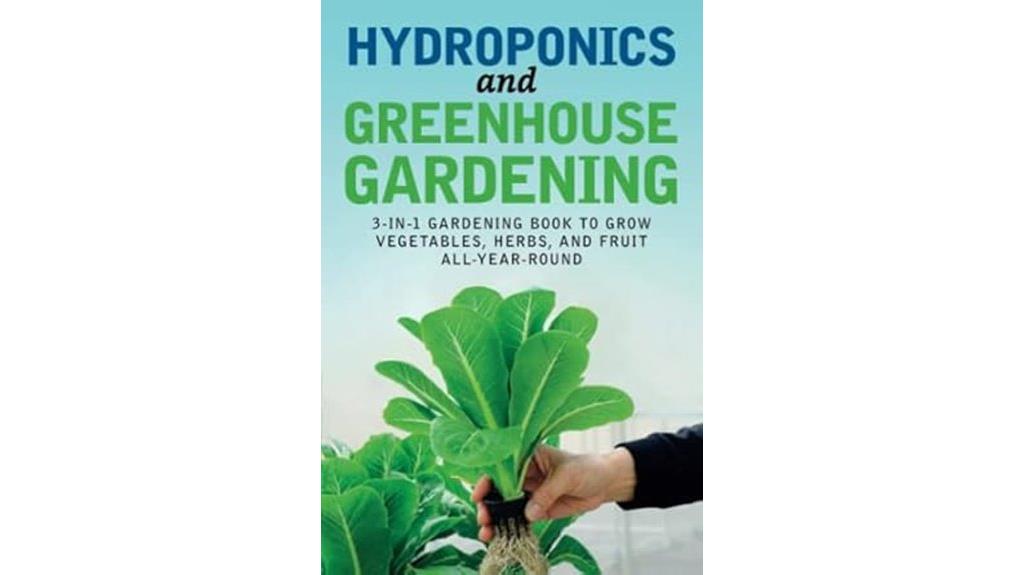
For anyone enthusiastic to immerse themselves in the world of hydroponics and greenhouse gardening, the "Hydroponics and Greenhouse Gardening: 3-in-1 Gardening Book" is an excellent choice. This book offers thorough information tailored for beginners, covering various hydroponic systems and practical home gardening techniques. I found its easy-to-understand format incredibly helpful. It provides detailed DIY methods for setting up your own systems and gardens, ensuring year-round produce. While some readers wished for more visual aids, the book's solid advice and lasting value make it a go-to resource. Overall, it's perfect for anyone ready to engage in hydroponic gardening.
Best For: Beginners interested in hydroponics and greenhouse gardening looking for practical guidance and DIY methods for home gardening.
Pros:
- Detailed explanations of various hydroponic systems and gardening techniques.
- Easy-to-understand format that encourages year-round gardening.
- Valuable resource for reference, offering lasting support for gardeners at any level.
Cons:
- Lacks advanced topics in hydroponics, such as aquaponics.
- Some readers feel the content lacks depth in certain areas.
- Limited visual aids like pictures and diagrams may hinder learning for novices.
How to Build a Greenhouse
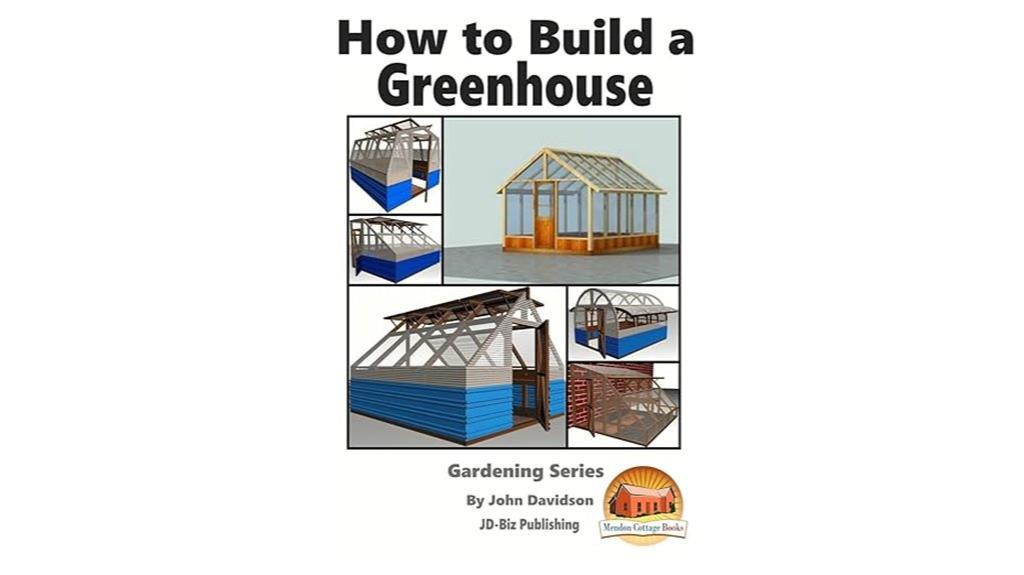
Building a greenhouse is an exciting project for anyone enthusiastic to grow fresh herbs year-round. I've found that while there are many resources available, some books can be lacking. For instance, I came across one that offered generic instructions without a detailed lumber list or any sketches. It felt more like an advertisement for other materials than a true guide. Instead, I recommend searching online for free plans that provide clearer instructions. You'll find better examples and practical tips to help you create the perfect greenhouse for your herb garden. Happy building!
Best For: Beginners looking for a basic introduction to greenhouse building, but may need to supplement with additional resources.
Pros:
- Filled with LOTS of information!
- Multiple build examples provided.
- Good for beginners who need an overview.
Cons:
- Did not provide a lumber list or detailed plans.
- Lacked sketches, drawings, or pictures for clarity.
- Ends with ads for other books, feeling promotional rather than informative.
Greenhouse Gardening – A Beginners Guide to Growing Fruit and Vegetables All Year Round
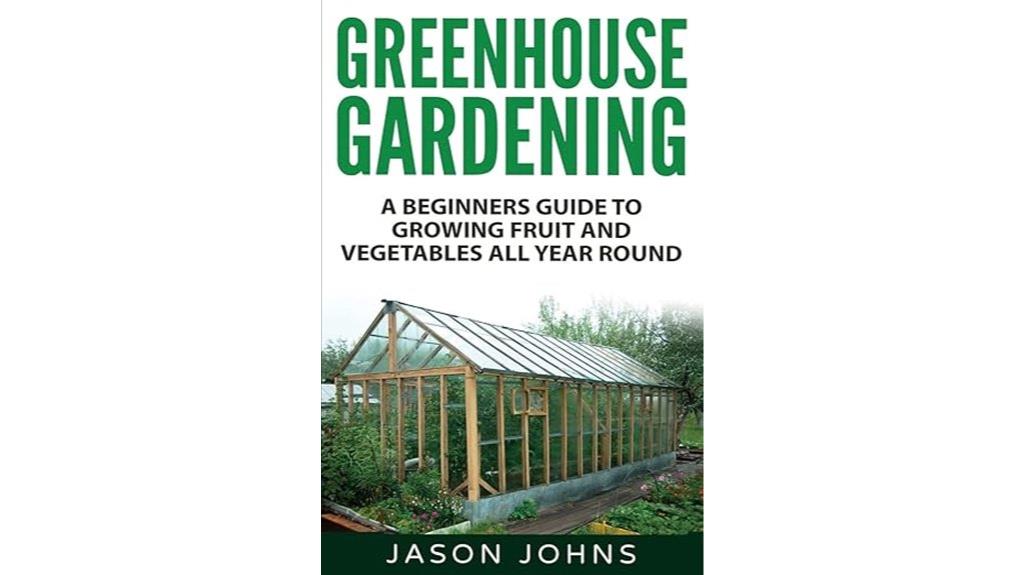
Starting your greenhouse gardening journey can be incredibly rewarding, especially if you're passionate about growing your own fresh herbs. I found Jason Johns' "Greenhouse Gardening: A Beginners Guide to Growing Fruit & Vegetables All Year Round" to be an invaluable resource. It walks you through selecting the right greenhouse, building a solid foundation, and ensuring proper irrigation and ventilation. The practical advice on extending your growing season and managing pests has transformed my approach. With clear, step-by-step guidance, this book makes it easy for beginners to cultivate a thriving greenhouse full of vibrant fruits and vegetables year-round.
Best For: Beginners looking to start their greenhouse gardening journey with practical guidance and insights.
Pros:
- Provides step-by-step instructions that are easy to follow for novice gardeners.
- Offers practical tips on pest management and environmental control to enhance plant growth.
- Includes insights on a variety of fruits and vegetables, making it versatile for different gardening interests.
Cons:
- May not offer enough advanced techniques for experienced gardeners seeking in-depth knowledge.
- Primarily focuses on larger greenhouse setups, which may not cater to those with smaller spaces.
- Some readers may find the information basic if they already have a foundational understanding of gardening.
Greenhouses & Garden Sheds: Inspiration & Projects
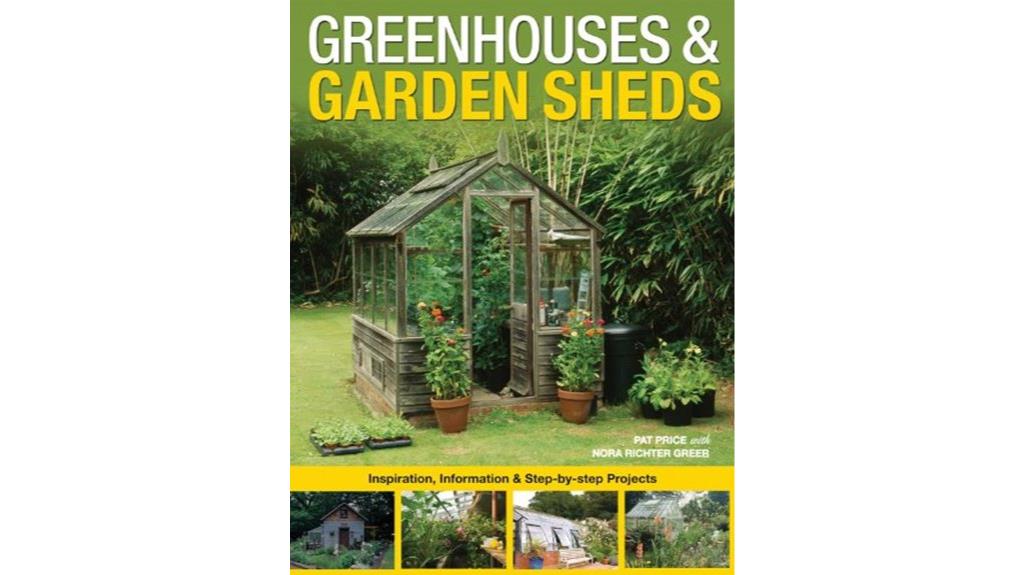
If you're a gardening enthusiast keen to cultivate fresh herbs year-round, "Herb Greenhouse Plans for Growing Fresh Herbs" is your ideal companion. The book "Greenhouses & Garden Sheds" offers fantastic inspiration and practical projects for building your own space. It covers everything from positioning and design to heating and watering, making it perfect for beginners. I love the clear visuals and sketches that help me visualize my projects. While it might lack some detailed construction specifics, it's still a great resource. I recommend grabbing your own copy—many readers have, and you'll find it invaluable for your gardening journey!
Best For: Beginners looking to build and use greenhouses and garden sheds, particularly those interested in practical projects and clear visual guidance.
Pros:
- Extensive information on greenhouse types, positioning, design, and internal layouts.
- Clear visuals and sketches that enhance understanding and visualization of projects.
- Practical guidance and easy-to-follow instructions make it suitable for amateur builders.
Cons:
- Some readers may find the lack of detailed construction specifics a drawback.
- May not cater to advanced gardeners seeking in-depth techniques.
- Limited coverage on advanced heating and lighting systems for more complex setups.
Factors to Consider When Choosing Herb Greenhouse Plans

When I think about choosing herb greenhouse plans, several key factors come to mind. I need to take into account the climate and temperature control, as well as the size and space requirements for my herbs. Additionally, the materials, ventilation, and light placement are essential to guarantee a thriving environment.
Climate and Temperature Control
Understanding the specific climate of your region is essential for effective herb greenhouse plans, as temperature variations can greatly influence herb growth and yield. I've learned that many herbs thrive between 65°F to 75°F during the day, and it's vital to keep nighttime temperatures above 50°F to avoid stunting growth. To maintain these conditions, I recommend installing effective temperature control systems, like ventilation and heating options. Additionally, designing your greenhouse to harness passive solar heating and cooling can help regulate temperature fluctuations naturally. Don't forget about humidity levels; most herbs prefer a range of 40-60%. Monitoring both temperature and humidity guarantees your herbs will flourish year-round, giving you a bountiful harvest.
Size and Space Requirements
Choosing the right size and space for your herb greenhouse is essential to your gardening success. First, assess the available area in your yard, as this will dictate what you can build. A small greenhouse (around 6×8 feet) is perfect for a few herb varieties, but if you want more selection and better air circulation, consider a larger model (10×12 feet or more). Don't forget about height; taller structures can accommodate larger herbs, while shorter ones work for compact varieties. Also, check local zoning regulations, as they might limit your greenhouse's size and placement. Ultimately, make sure your greenhouse aligns with your gardening goals, whether for personal use or small-scale commercial production, to maximize efficiency and accessibility.
Greenhouse Materials Selection
Selecting the right materials for your herb greenhouse can make all the difference in your gardening experience. I recommend considering polycarbonate for its excellent insulation and durability, or polyethylene film for a more budget-friendly option that still allows ample light. For the frame, aluminum is a great choice since it's lightweight and corrosion-resistant, while wood adds charm but requires upkeep to prevent rot. Don't forget to choose materials that can withstand your local weather, including wind and snow. To promote air circulation and prevent overheating, opt for roof vents and sidewalls made from mesh or polycarbonate. Ultimately, a double-layered glazing option will improve energy efficiency, making it easier to keep your herbs thriving year-round.
Ventilation and Humidity Management
While the right materials are essential for a successful herb greenhouse, managing ventilation and humidity is just as crucial. Proper ventilation helps control humidity levels, preventing stagnant air that can lead to mold and mildew on your herbs. I've found that installing exhaust fans or roof vents works wonders by allowing hot, humid air to escape while drawing in cooler, drier air. Regularly monitoring humidity with a hygrometer keeps conditions within the ideal 40-60% range for healthy growth. For plants that love humidity, I use humidity trays filled with water, which also helps with evaporation. Finally, don't forget shading techniques like shade cloths to prevent excessive heat build-up, which can stress your plants and raise humidity levels.
Light Requirements and Placement
When planning your herb greenhouse, understanding light requirements and placement is essential for healthy plant growth. Herbs thrive on 12 to 16 hours of light daily, so choosing a southern exposure can maximize sunlight and reduce shadows from nearby structures. During shorter daylight months, I find that supplemental lighting, like LED grow lights, makes a big difference in keeping my herbs happy and thriving. Additionally, using light-reflective materials in the greenhouse can enhance natural light distribution, further promoting growth. Don't forget about bench and shelving placement; ensuring all herbs receive equal access to light prevents overcrowding and shading, which can hinder their development. By considering these factors, I've seen my herb garden flourish year-round.
Accessibility and Maintenance Ease
Accessibility and maintenance ease are vital elements I consider in my herb greenhouse plans. I always look for layouts that provide clear pathways, making it easy to navigate and tend to my plants. Efficient ventilation and light exposure are critical, as they help maintain a healthy garden environment. I prefer designs that incorporate shelving or potting benches, allowing me to organize and access my herbs without excessive bending or reaching. Simple irrigation systems are a must, as they save me time and effort during watering. Finally, I opt for greenhouses made from easy-to-clean materials, which streamline maintenance and guarantee a hygienic space for my herbs to thrive. These features truly simplify my gardening experience.
Budget and Cost Considerations
Budgeting for a greenhouse can feel overwhelming, but it's essential for a successful herb garden. I always start by determining my budget since costs can vary widely based on materials, size, and design complexity. For instance, basic hoop houses might cost around $100, while more sturdy structures can exceed $1,000. I also consider additional expenses like heating, cooling systems, and ventilation, which can considerably impact my initial investment. Don't forget ongoing costs for maintenance and utilities, as these will affect my long-term budget. Finally, I research local building codes and permit fees, since these can influence my planning and overall financial commitment. A clear budget helps me stay on track and avoid overspending.
Frequently Asked Questions
What Herbs Are Best Suited for Greenhouse Growing?
When I think about which herbs thrive in a greenhouse, I immediately consider basil, cilantro, and parsley. These herbs love the warm, controlled environment a greenhouse provides. I've also had great success with thyme and oregano, which are quite resilient. If you're looking to grow year-round, mint is another fantastic choice. Each of these herbs not only adds flavor to dishes but also grows beautifully in a greenhouse setting.
How Much Sunlight Do Herbs Need in a Greenhouse?
Imagine a sunbeam dancing on a leaf, nurturing it like a gentle parent. In my greenhouse, I've found that most herbs thrive with about 6 to 8 hours of sunlight daily. I position my plants near windows or use grow lights to guarantee they bask in that warm embrace. This balance of light helps them flourish, turning my little space into a vibrant oasis of fresh flavors, ready for culinary adventures.
Can I Use Hydroponics in My Herb Greenhouse?
Absolutely, you can use hydroponics in your herb greenhouse! I've found it to be a game-changer for growing fresh herbs efficiently. With hydroponics, I can control nutrients and water better, leading to faster growth and vibrant flavors. Plus, it saves space, which is perfect for my setup. Just make sure to choose the right system and monitor your herbs closely, and you'll be amazed at the results!
What Temperature Should I Maintain in a Herb Greenhouse?
Imagine your herbs basking in the warmth of a gentle sun, thriving in a perfect environment. I've found that maintaining a temperature between 65°F and 75°F keeps my herb greenhouse flourishing. It's like creating a cozy blanket for them, encouraging growth and energy. If it dips too low or rises too high, I notice my herbs struggle. So, I keep a close eye on the thermometer, ensuring my green friends feel just right.
How Often Should I Water Herbs Grown in a Greenhouse?
When I'm growing herbs in my greenhouse, I usually water them about once a week, but it really depends on the humidity and temperature. I check the soil moisture regularly; if it feels dry an inch down, it's time to water. I've found that over-watering can be just as harmful as under-watering, so I keep an eye on the plants. Healthy herbs thrive with just the right amount of water!
Conclusion
In wrapping up, I hope you feel inspired to immerse yourself in greenhouse gardening and cultivate your own fresh herbs year-round. Just like a well-tended garden, your dreams can blossom with the right plans in hand. As you explore the various designs, remember that each greenhouse is a reflection of your personal touch. So, roll up your sleeves and let your passion for gardening flourish—your herb oasis awaits just outside your door!
